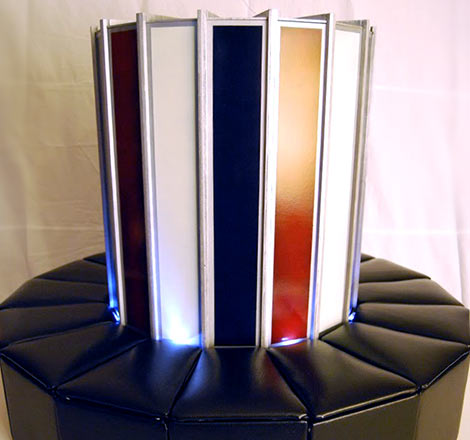
35 years following its introduction, and despite fewer than 100 systems deployed, the Cray-1 remains one of the most recognizable computers in history; it is a timeless icon of pure supercomputer badassery. Custom case builder [Daryl Brach] pays homage to this classic with his third-scale model housing two modern PC motherboards.
In an interesting reversal, the base of the model — the upholstered bench that housed cooling and power distribution for the original Cray — holds the PC motherboards and storage, while the upper section is currently just for show but may house a water cooling rig in the future. The paint scheme is inspired by the Cray-1 on display at the Smithsonian, though Daryl’s model does make a few modern concessions such as LED lighting. Hinged panels in the base flip open to access the systems’ optical drives (perhaps to watch Tron on DVD).
The Cray-1 ran at 80 MHz and could house up to eight megabytes of memory…just about unfathomable performance in its day. It’s not clear what processors [Daryl] chose to outfit his system with, but regardless, even an entry-level modern PC doesn’t just run circles around its progenitor, it runs ray-traced glass spheres around it. Technology marches on, but good design never goes out of style.
















Nice! Reminds me of a warp core, sort of.
Yeah, reminds me of any of the alien-based computer cores that you would find on the original star trek series. Cool, but I’m a little ashamed I wasn’t immediately familiar with the Cray computers…
Which Cray had the “waterfall” on the front? I’m assuming this was part of the cooling system. I want a case like that.
The Cray-2 (1984) had a “waterfall” filled with the liquid Fourinert (3M’s artificial plasma) topping the reservoir.
gotta love cray supercomputers, the cray-1 in particular had a crazy amount of wiring inside the semi-triangular compartments, almost no space left inside actually.
Wow. My dad took me to see a real one as a kid. This one looks authentic.
(I worked at Cray for 16 years)
The Cray-2’s circuitry was immersed in a transparent liquid for cooling (3M’s Flourinert)
The waterfall was to keep the pressure in the tank juuuuust right.
Now, how bout some wiring from the Cray-3?
http://bobodyne.com/web-docs/robots/cray3/index.html
http://upload.wikimedia.org/wikipedia/commons/3/3d/Cray-3_processor_brick.jpg
GREAT job!
His model only has 11 columns.
The Cray1 had 12 columns.
“ray-traced glass spheres” lol
Nice job, [Daryl Brach]. Can you do a replica Connection Machine next? There’s some reeeeal supercomputer bad-assery. Unlike Crays, which had comfy benches you could sit on, Connection Machines had open spaces in front of them where you could KNEEL AND WORSHIP.
I want one, we need a new couch and a new HTPC, problem solved…
great work.
Nice to see how useful projects people spending their time on. Lol that computer reminds me from the ones from thron and superman. I never liked those big cases and now my iphone is faster than those althogether.
I remember seeing the Cray-1 at the Smithsonian and being blown away by the *hand wired* guts! This is a really great build – thanks for sharing!
That is cooler than the other side of the pillow!
@AlanKilian It’s a shame that there’s no justification for making a cool looking supercomputer chassis anymore.
Niiiice. I plan on buying one of the “newer” Crays…probably not to use it but just to have it around the house..though I think the Cray-1 is pretty cool looking by itself. I made my kids look at it when we visited the Smithsonian this summer…they actually were kinda impressed..
My father worked one of the Cray supercomputers for years. Seeing this really hits home for me. Nice job.
I actually built a cycle-accurate Cray-1 in an FPGA, although my case is only 1:10 scale (not 1:6 – that thing is huge!).
@AlanKilian – Do you know of anyone that still has any Cray-1 software archived??? I’ve had a terrible time trying to track any down.
Scaled down further, this would make a fun case for the shop computer. Even this scale or larger would be OK if the case was built to do extra duty as tool or parts storage. Also multiple conventional tower cased computers could be arranged similarly, and dressed up to resemble the Cray to make a “soupercomputer”. For those who hacking has to have a purpose, the computers could run distributed application like seti@home. The biggest problem I can see is the power bill.
I got to see one in operation in 1981 that was owned by the USAF. What you don’t see in the picture of the cool C-shaped benched CPU is the 20,000 square foot floor of disk drives, tape drives, and other peripherals that were necessary to feed the beast data and collect its output. As with the CPU, today you can hold that amount of computing power in your hand — you’re smacking it to the ground if you own an iPhone.
iPhone tried to destroy the Cray…
IT FAILED, AND WAS THROWN TO THE GROUND!!
(Sorry, it’s what you made me think)
Sadly it’s not very comfy to sit on.
The Cray -1 ran near 150 Mips. The reason for the shape (the round tower) was to keep the backplane wires short as possible. The wiring was actually “tuned” for performance. Frequently the tuning was so critical that if you owned a Cray-1 you also “owned” a programmer that could tune the software (ie timed loops). it was touchy equipment and was frequently “offline”.